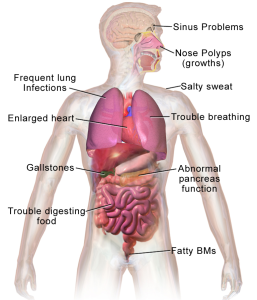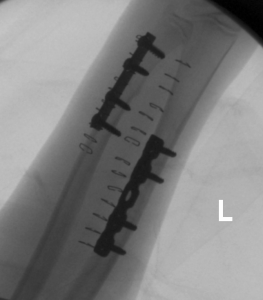4.6 Diseases and Symptoms
This section focuses on abbreviations related to diseases and symptoms. The tables below list the more common abbreviations that you might see in a healthcare setting. The key concepts and some example orders are provided to help you understand the terms by explaining how they could be used.
Table 4.22. Diseases and Symptoms
| ABBREVIATION | MEANING |
| AD | Alzheimer’s disease |
| ASHD | arteriosclerotic heart disease |
| BPH | benign prostatic hypertrophy |
| CA | cancer |
| CF | cystic fibrosis |
| CHF | congestive heart failure |
| COPD | chronic obstructive pulmonary disease |
| CP | cerebral palsy |
| CVA | cerebrovascular accident |
Key Concepts

Cerebral palsy (CP), which literally means “weakness pertaining to the brain,” is one of the most common childhood disorders that affects
mobility (CDC, 2022). It is caused either by some sort of trauma to the brain or abnormal brain development. The severity of the disorder varies from person to person. Some individuals will rely on equipment to assist with mobility, whereas others do not use aids but might find ambulating a little more difficult.
Cystic fibrosis (CF) is one of the most common genetic diseases that affects children. It predominantly affects the digestive system and the lungs (Cystic Fibrosis Canada, 2020). Fig. 4.13 shows some additional effects of CF on the body’s organs. Some of the common complications of CF include poor nutrition related to the inability to digest fats and recurring lung infections that in turn lead to lung damage.
Examples of orders related to diseases and symptoms:
- Dx L side CVA
- Hx of ASHD
Explanation of orders related to diseases and symptoms :
- Diagnosis of left-side cerebral vascular accident.
- History of arteriosclerotic heart disease.
Table 4.23. Diseases and Symptoms
| ABBREVIATION | MEANING |
| DT | delirium tremens |
| DVT | deep vein thrombosis |
| GERD | gastroesophageal reflux disease |
| HBV | hepatitis B virus |
| HCV | hepatitis C virus |
| HIV | human immunodeficiency virus |
| HPV | human papilloma virus |
| HTN | hypertension |
Key Concept
Delirium tremens (DT) is a form of severe withdrawal from alcohol in which symptoms typically appear two to three days after a person has stopped drinking alcohol (Bernstein, 2020). Possible symptoms include confusion, major changes in behaviour, and seizures. Most hospitals have a protocol that they follow if they suspect that a patient is dependent on alcohol.
Examples of orders related to diseases and symptoms:
- Heparin 5000 units sc bid due to Hx of DVT
- Head MRI today to determine if patient had a CVA
Explanation of orders related to diseases and symptoms:
- Heparin 5000 units subcutaneous twice a day due to a history of deep vein thrombosis.
- Head magnetic resonance imaging today to determine if patient has had a cerebrovascular accident.
Table 4.24. Diseases and Symptoms
| ABBREVIATION | MEANING |
| IBD | inflammatory bowel disease |
| IBS | irritable bowel syndrome |
| MI | myocardial infarction |
| MS | multiple sclerosis |
| N&V | nausea and vomiting |
| NYD | not yet diagnosed |
| OA | osteoarthritis |
| ORIF | open reduction internal fixation |
Key Concept

Open reduction internal fixation (ORIF) is a surgery performed to any fracture that cannot be repaired by casting or other non-surgical methods (Healthline, 2018). “Open” means that an incision needs to be performed, and “internal fixation” means that the bones must be realigned using some sort of hardware (screws, wires, or plates) to keep them in place. This a a common surgery on an orthopedic unit. Fig. 4.14 is an image of an ORIF of fractures to the left radius and ulna that have been repaired using screws to realign each bone.
Examples of orders related to diseases and symptoms:
- Patient has abdominal pain, NYD
- ORIF to L wrist Fx
Explanation of orders related to diseases and symptoms:
- Patient has abdominal pain, not yet diagnosed.
- Open reduction internal fixation to left wrist fracture.
Table 4.25. Diseases and Symptoms
| ABBREVIATION | MEANING |
| PVD | peripheral vascular disease |
| SARS | severe acute respiratory syndrome |
| SIDS | sudden infant death syndrome |
| SOB | shortness of breath |
| Staph | bacterial infection (Staphylococcus) |
| STD/STI | sexually transmitted disease/infection |
| Strep | bacterial infection (Streptococcus) |
| TB | tuberculosis |
| TIA | transient ischemic attack |
| UTI | urinary tract infection |
| VT, V tach | ventricular tachycardia |
Key Concept
Sudden infant death syndrome (SIDS) occurs when a baby dies unexpectedly, usually during sleep. Infants are often under the age of one year and the cause is unknown (Mayo Clinic, 2022). Researchers have found that putting a baby to sleep on their back may help prevent SIDS.
Examples of orders related to diseases and symptoms:
- Keep head of bed elevated due to SOB
- Hx of PVD and TIA
Explanation of orders related to diseases and symptoms:
- Keep head of bed elevated due to shortness of breath.
- History of peripheral vascular disease and transient ischemic attack.
Exercise
Attribution
Unless otherwise indicated, material on this page has been adapted from the following resource:
Carter, K., & Rutherford, M. (2020). Building a medical terminology foundation. eCampusOntario. https://ecampusontario.pressbooks.pub/medicalterminology/ licensed under CC BY 4.0
References
Bernstein, S. (2020). Delirium tremens. WebMD. https://www.webmd.com/mental-health/addiction/delirium-tremens#:~:text=Delirium%20tremens%2C%20also%20called%20DTs,as%20long%20as%20a%20week
Centers for Disease Control and Prevention (CDC). (2022). What is cerebral palsy? https://www.cdc.gov/ncbddd/cp/facts.html#:~:text=Cerebral%20palsy%20(CP)%20is%20a,problems%20with%20using%20the%20muscles
Cystic Fibrosis Canada. (2020). What is cystic fibrosis? https://www.cysticfibrosis.ca/about-cf/what-is-cystic-fibrosis
Healthline. (2018). Repairing major bone breaks with open reduction internal fixation surgery. https://www.healthline.com/health/orif-surgery
Mayo Clinic. (2022). Sudden infant death syndrome (SIDS). https://www.mayoclinic.org/diseases-conditions/sudden-infant-death-syndrome/symptoms-causes/syc-20352800
Image Credits (images are listed in order of appearance)

